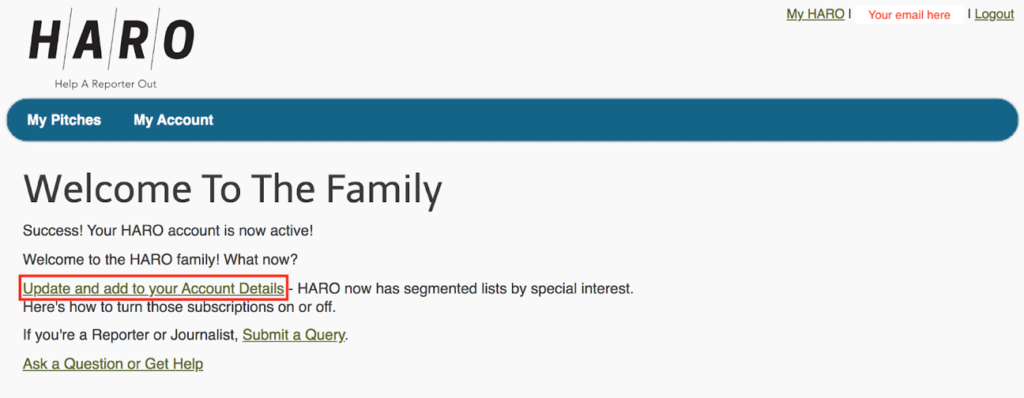How to Use HARO for Backlinks and Content Marketing
Not sure how to use HARO for backlinks? Or maybe you strive to get your SEO strategy to the next level? With the help of HARO, you can do both and even more!
Read this article to know exactly how to use HARO to build backlinks to your website, increase your SEO performance, improve your content marketing, and promote your content to wider audiences.
In this article you’ll learn:
- What is HARO and how does it work
- How to get started with HARO
- 5 examples of successful HARO pitches
- How to use HARO for backlinks
- How to use HARO for content marketing
- How to use HARO to promote your content
- Templates you can use to share your content
But first, let’s start from the very beginning.
What is HARO and How HARO works?
HARO, or Help A Reporter Out, is an online free service that connects journalists looking for specific expertise to include in their content with sources who have that knowledge and would like to share it.
This platform was founded in 2008 as a Facebook group and was turned later into a mailing list. HARO has come all the way through to be the most effective online service to help you increase your brand awareness, build trustworthy links, and create unique and relevant content.
Despite HARO was originally a tool, particularly for journalists, now it’s also used by marketers, link-building experts, PR specialists, and online business owners worldwide.
HARO is working in two directions:

1. Reporters can submit requests to the HARO community to find relevant sources in order to create a unique story, interview, or blog post.
2. Sources are able to look for the most relevant queries they have expertise in and share their specific knowledge to get media coverage while earning high-quality links.
The platform has implemented changes over years and now you can choose between free and paid subscriptions. There will be no problem if you opt for using the basic free option as you still will be able to use HARO for building links and getting media coverage.
Paid subscriptions were created to free your time on filtering out keywords through media opportunities via automation and customization features so you could build links and get websites the attention they deserve much faster.

Getting Started with HARO
In order to start using the HARO link building service and unveil its full potential, you have to follow 2 simple steps to sign up for your HARO account:
1. Click on SIGN UP and fill out the form. In order to activate your free account, don’t forget to verify the link in your email.

2. After you’re redirected to a welcome page, you have to set up your new HARO account.

First, make sure to tick the correct account type: reporter, source, or sponsor.

After, I highly recommend you define HARO preferences as this step will ensure you get the right HARO queries. Keep in mind that by default only “master HARO” will be chosen, but you can be specific and customize the preferences to your link-building strategy and filter out different categories if you wish to receive queries on those topics.
This will help you categorize questions to be able to cut through the noise of popping up queries every day.

Note that some topics are colored in grey and have an information symbol right next to them. These are the topics that haven’t gathered enough queries.
You can tick them anyway to be notified when one of them will gather enough HARO requests.
And this is basically it with setting up HARO. From now on, the platform will be sending you emails where the subject will be the actual topic of the query listed. Keep looking for the most relevant and start responding to use HARO link building like a Pro.
Successful HARO Pitch [Templates]
Yes, your pitch has to be unique, but who said you can’t use a little bit of help with pitch structure? Let’s get straight to my actionable tips.
Long story short, each HARO pitch should contain the following blocks of information (make sure to tick all the boxes before submitting your pitch to journalists):
- Pitch Subject Line. This is an important factor that defines whether reporters will decide to read your pitch at all. Therefore your subject line should be catchy and click-worthy.
- Greeting. My advice is to always use the journalists’ first names.
- Pitch Intro. You need to tell media outlets who are you and why they can rely on your opinion. Here just start with your name and the company you represent followed by the accomplishments that support your credibility.
- Answer the Query. This is your moment to shine and earn the authority links for your contributions. Make sure to keep your HARO emails concise and straight to the point.
- Author Bio. Now it’s time to tell the media outlet a little more details about you and your business. Let them know what differentiates you from other expert sources and why top publications have to give that backlink to you.
- Pitch Ending. Don’t forget to thank the reporters for their time and mention that you look forward to speaking to them soon.

HARO Pitch Example #1
Good morning, [reporter name]!
My name is [your name]. I am a [state your credentials] and [role of company/blog name], a [company/blog] that has been mentioned in [list of other media appearances].
I saw your request on HARO and think I have a unique perspective to offer.
[answer the query]
If possible, I would greatly appreciate giving credit to [blog or company name] with a link to [insert link here].
If you decide to use my response in the article, please let me know when it is published so that I can help promote it across our social media platforms!
Thank you so much for your time and consideration, [insert reporter name].
[your name]
HARO Pitch Example #2
Hi [reporter name]!
My name is [name] and I am a [job title] for [company name with link to website]. I have extensive experience in [specific subject] because [add why you are qualified to respond].
In reference to your query on [subject], I think [answer the query].
Let me know if you need any more information! I am happy to speak with you more about [topic].
Sincerely,
[your name]
[title and business with lin to website]
[phone number and email]
[twitter handle, LinkedIn, etc]
[headshot]
HARO Pitch Example #3
Hi [reporter name]!
Regarding your request on [the query].
My name is [name], [your job title] at [company name with link], [explain what the company does and mention some relevant achievements].
[answer the query].
Let me know if you need any more information! I am happy to speak with you more about [topic].
Sincerely,
[your name]
HARO Pitch Example #4
Hello [reporter name]!
I hope you’re well! I came across your HARO query and
am happy to assist. To answer your questions:
[answer the query].
A little bit about myself: [brief bio].
Many thanks for your consideration. Feel free to reach
out if I can be a further resource in the future! Have a
lovely day!
[your name]
HARO Pitch Example #5
Hello [reporter name]!
I hope you’re well! I came across your HARO query on [name the topic of the query] and I am happy to assist.
From: [name, company, URL]
[answer the query]
Many thanks for your consideration. Feel free to reach out if I can be a further resource in the future! Have a lovely day!
[your name]
How to Use Haro for Backlinks
Link building is the number one reason why marketers are using HARO for SEO as a part of their link-building strategies. Recently, this platform became very popular among most businesses.
The huge benefit of this service lies in its incredible opportunity to build backlinks and increase the domain rating of your website.

Because branded links from the authoritative media domains are considered one of the most trustworthy by Google, you shouldn’t miss this kind of opportunity of implementing HARO backlinks in order to improve your SEO performance.
There is a common misconception that journalists are not happy to include some third-party business insider information in their pieces of content, but this is not true.
In fact, they will be more than happy to use the HARO service because this way it’s much easier for them to meet their deadlines and decrease time spent on a specific task.
HARO has been so popular because this is a pure win-win situation. Journalists don’t have to struggle anymore in order to find relevant sources for a big publication. They just submit a request and wait until the most suitable pitch knocks on their email with just a little effort.
Journalists will then leave a high authority link to the contributors’ websites in the article that will improve their SEO and pave the way to the first page. Sounds like a great idea because it makes building backlinks much easier, right?

You have helped a reporter out and got a relevant, trustworthy, and high authority backlink for your website as “thank you for your help” in return.
Note that you won’t be the only one submitting your expertise. That is why you have to make sure you’ve given the most specific and valuable answer.
Remember, the easier you made things for the reporter, the more likely your answer will be chosen among all the pitches and you would contribute to the article while getting quality backlinks.
Using HARO for Site Content
Link building is not the only reason businesses use HARO. Having the most unique pieces of content is inevitable in order to rank higher in search engines. That is why HARO is such a valuable tool and a good strategy for any online business owner.
With its help, you can include first-person quotes and the most trustworthy tips in your content to become the number one resource that people use for advice.

For example, you aim to create a blog post with the top 10 resources that will help your reader to improve copywriting skills.
Here you have 3 options:
1. Turn the internet upside down while searching for the best resources yourself, filter them out by testing how good they really are, and only then (finally!) begin writing your article.
2. Use already written blog posts and guides on the internet to rephrase and sum them up in your article.
3. Asking HARO sources to share their unique tips which have helped them to improve their copywriting skills. Then filter out the top 10 answers and frame them in the blog post.

The first option will take too much time that could be spent on rather valuable marketing activities for your business. The article in the second option will come up questionably unique for search engines. The third option will provide your users with a reader’s digest that would contain the most hands-on approaches.
This is how you take real input from people involved in the process and fill your sites with unique quotes to support each idea or tip. And you don’t have to be one of the top publications like the Wall Street Journal or Washington Post to do that.
Also, don’t forget to follow up with HARO users whose information you’ve included in your article. Despite it’s not required from you, this way you can build worthy networking which you can use in your future queries to get responses faster.
The other way you can benefit from using HARO is to update your old content with more relevant information. It is known that for an effective SEO you have to review the content and links on your own websites every six months.
First, you identify which piece of content is strategically valuable for you, and then you use help a reporter out contributors to enrich it with additional tips or relevant quotes. This way you can refresh old articles and increase organic traffic to them.
Here are some tips to consider where you might need an update:
- Analyze the search intent of keywords you’re ranking for and look for ways to improve it.
- Monitor keywords that you get the most impressions for and start targeting them.
- Find out what keywords bring the most traffic to your competitors. Then start working on that gaps in your content.
Using HARO for Content Promotion
When publishing HARO-enriched pieces of content, you have to leave backlinks to all the contributors.
Here is where content promotion comes into play. I can’t stress enough how important it is to build relationships with people contributing to your work. This way you can reach out to each one of them when the article is ready, say how grateful you’re for their help, and ask them to share your final result with their audiences.

Template of the email you can use to share your links:
Thanks for your help!
The article you contributed to is live here: [provide a link].
Please let us know if anything needs to be updated or changed.
We’ll also be sharing it on Facebook and LinkedIn in the coming days – we’d love it if you do the same.
Have a good weekend,
[your name]
While reaching out to contributors with emails, make sure to make it extremely easy for them to share links to your content.
You can do it by writing a post specifically for social media intent, briefly expressing why the following piece of content is worth reading, and tagging everyone whose input you’ve added.
Example of such a post:

Final thoughts
You can keep pretending HARO link building isn’t worth your time and continue with what’s been effective for your SEO till now. It’s always up to you whether or not to give it a shot, but in case you would consider trying it out, make sure you use this free service to its fullest extent.
The majority of marketers use this platform only to passively earn HARO links. Although there’s nothing bad with wishing to get more links, don’t be among link builders who are missing out on opportunities.
Set up your HARO account to generate high-quality backlinks to your website, increase your brand’s awareness, create unique pieces of content that users are looking for, and promote your content to a wider audience.











